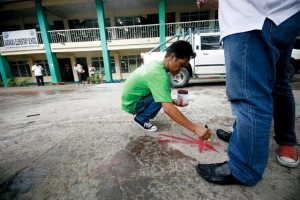THE Department of Education (DepEd) has laid out contingency plans for schools that may be affected by the West Valley Fault (WVF) to ensure the safety of students and teachers who are expected to be back in school on June 1.
Two of these schools--Pedro E. Diaz High School (PEDHS) and Alabang Elementary School (AES) in Muntinlupa City (Mero Manila)--were inspected by Education Secretary Armin Luistro on Thursday.
Meanwhile, the Metropolitan Manila Development Authority (MMDA), in a move to get the public prepared for the “Big One,” on Friday announced that it will roll out next week its “Earthquake Preparedness Website.”
According to the MMDA, the website will contain vital information on how to survive a strong quake in case it hits Metro Manila or the National Capital Region.
The website, it said, can be accessed through www.bepreparedmetromanila.com.
It will also familiarize the public on the do’s and don’t’s before, during and after an earthquake, the MMDA added.
MMDA Chairman Francis Tolentino said the website aims to promote pro-active participation and disseminate wide-ranging information about earthquake readiness and risk reduction.
“The main premise of the website is to inculcate the importance of preparedness in these challenging times. I am urging everyone to visit the website and try to learn as much information as they can,” Tolentino explained.
The website contains an atlas of the Valley Fault System, a video of the Greater Metro Manila Area Risk Analysis conducted by Ausaid, and contact numbers of national and local emergency response units.
It also features a detailed description of the MMDA’s Oplan Metro Yakal, the agency’s disaster contingency measure.
“We have started program linkage with concerned government agencies and those in the private sector to be able to pool all resources and services that might be necessary to sustain the campaign,” Tolentino said.
During the inspection of the two schools in Muntinlupa, Luistro said school opening for PEDHS and AES will still be June 1, citing consultation with the Philippine Institute of Volcanology and Seismology and engineers on the structural integrity of the buildings in these schools.
Some parts of Muntinlupa City are said to be sitting on the West Valley Fault.
DepEd has also set out contingency plans for Karahume Elementary School in Norzagaray, Bulacan, which will also have its first day of classes on June 1.
School officials and personnel will orient the community leaders, around 50 percent of whom belong to the Dumagat tribe, on precautionary measures during an earthquake.
The Education department has sought the assistance of the local government of Karahume while waiting for assessment by the Department of Environment and Natural Resources of the need for early evacuation.
The move is in line with government efforts to sustain an educational campaign on the risks and dangers from a strong earthquake should it hit Metro Manila and nearby towns.
with RITCHIE A. HORARIO


